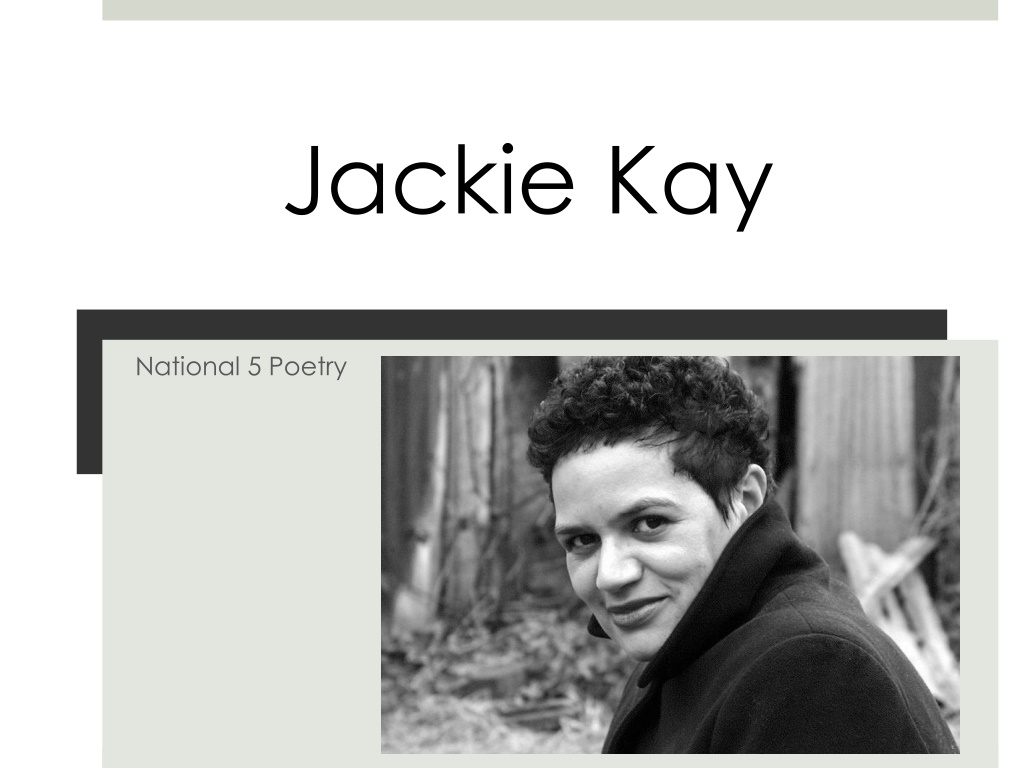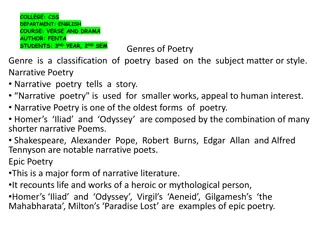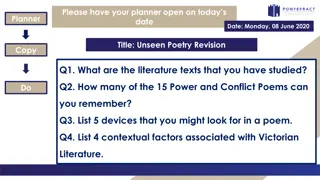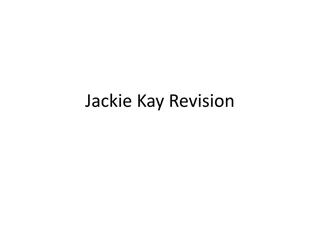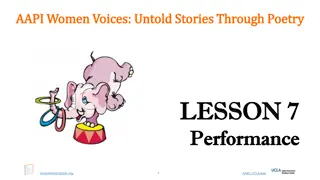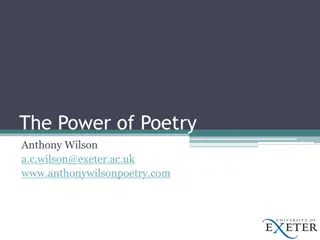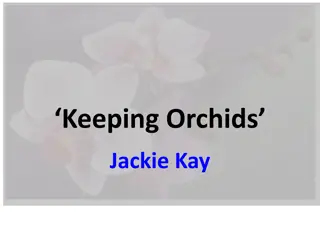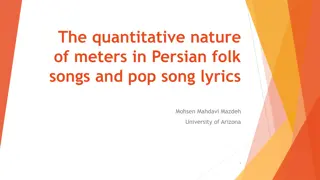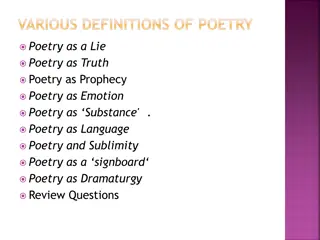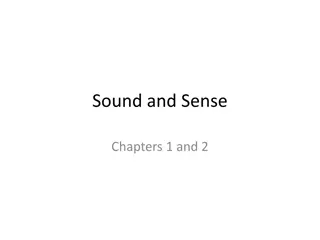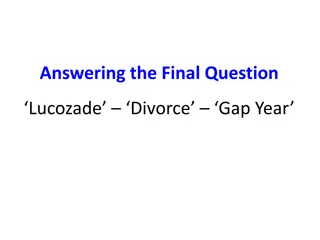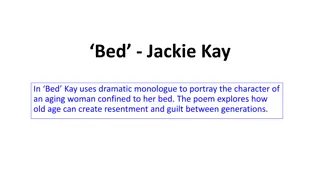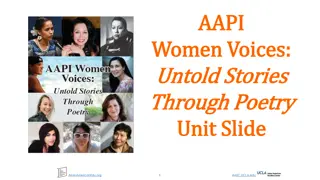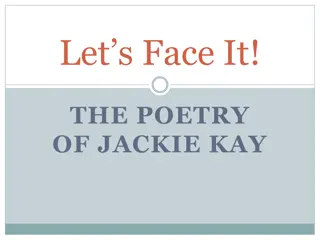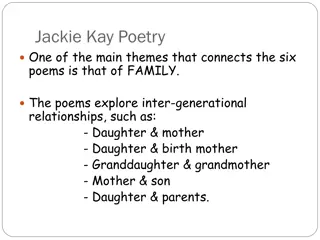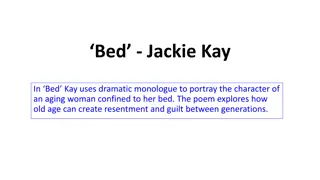Exploring Jackie Kay's Life and Poetry
Delve into the life and work of poet Jackie Kay through a fact-finding mission and quiz to understand her background and inspirations. Discover details about her birth, family, challenges faced, career choices, inspirations for poetry, awards received, and themes in her poetry. Engage in discussions about the themes of her poems and set learning intentions to analyze her poetry closely.
Download Presentation

Please find below an Image/Link to download the presentation.
The content on the website is provided AS IS for your information and personal use only. It may not be sold, licensed, or shared on other websites without obtaining consent from the author. Download presentation by click this link. If you encounter any issues during the download, it is possible that the publisher has removed the file from their server.
E N D
Presentation Transcript
Jackie Kay National 5 Poetry Jackie Kay
Fact Finding Mission: About the Poet Before we dive into the poems, it is important to understand the poet and her life. Working in groups you will read about Jackie Kay and participate in a quiz to test your knowledge. 1. As a group read the information. 2. Decide on what you think is important and write this down in your jotters. 3. As a group learn the information as best you can. (divide it, quiz each other etc.) 4. I will collect your information sheets when the buzzer goes off.
The Quiz Working as a group, try to answer the questions correctly. Write your answers down to be peer marked.
Quiz 1. In what location and year was Jackie Kay born? (2) 2. What were the nationalities and occupations of her parents? (4) 3. What challenge did she face during her childhood? (1) 4. What caused her to search for her birth mother? (1) 5. All writers draw on their own ___________ and a lot of my ____________ has been heightened' Fill in the blanks. (2) 6. What career did she first pursue? (1) 7. What made her change her mind? (2) 8. What country does Kay claim inspired her poetry? In what ways? (3) 9. Name at least one prize that Kay was awarded for her writing. (1) 10. Name at least one other voice that Kay has used in her poetry (1) 11. What has influenced her poetry? (1) Final question: Name as many themes in Kay s work as possible .(4)
Marking Trade your answers with another group. 1. Edinburgh; 1961. (2) 2. Mother Scottish, nurse; Father Nigerian, student. (4) 3. Racial bullying. (1) 4. The birth of her own son. (1) 5. Experience. (2) 6. Acting. (1) 7. Car accident; recognition by Alasdair Gray. (2) 8. Scotland; language and speech rhythms. (3) 9. Any of: Saltire First Book Award, Somerset Maugham Award and the Guardian Fiction Prize. (1 + extra if they have more than one correct) 10. Any of: mother, daughter, old woman, lover or child. (1 + extra) 11. Her awareness of her complex genetic inheritance (coming from a mix of backgrounds). (1) Final question: Racism, family relationships, misogyny, homophobia and human love. (possible 5 points) Give them a final mark out of 24.
Whats in a name? In pairs discuss the following questions: What do the names of the six poems we will study suggest to you? What do you think the poems will be about? What themes might they explore? Keeping Orchids Divorce Bed Gap Year Lucozade My Grandmother s Houses
Learning Intentions 1. Read and understand the main ideas of the poem Divorce . 2. Learn how to annotate the poem with analysis of poetic techniques. 3. Explore and analyse the poetic voice used.
Divorce Pre-reading: What does the title of the poem suggest that the subject matter of the poem will be about? What are your associations with the term divorce ? Write down at least 5 words that come to mind. Reader associates with a marriage breaking apart /parents splitting up Divorce
1st Stanza married couple supports expectations I did not promise to stay with you till death do us part, or Looking at the first 5 lines only discuss and make notes with the person next to you: anything like that, so part I must, and quickly. There are things I cannot suffer any longer: high, formal language gives impression that an adult is speaking 1. Who do you think is talking? 2. How do they talk? (language, register, tone etc.)
role reversal; something parents might complain about 1st Stanza any longer: Mother, you never, ever said a kind word or a thank-you for all the tedious chores I have done; Father, you breath smells like a camel s and gives me the hump; all you ever say is: Are you off in the cream puff, Lady Muck? In this day and age? I would be better off in an orphanage. a parent might say to a child grown up language After reading the rest of the stanza . Discuss: Who is actually talking? What evidence do you have for this? pun play on words haughty or pretentious woman. Suggests the speaker is being dramatic OTT; theatrical. Teenager talk Pun: a joke exploiting the different possible meanings of a word or the fact that there are words which sound alike but have different meanings.
2nd Stanza In pairs or groups of 3, you will be a given line(s) of the stanza. Write down your line in your jotter and annotate around it following my example. Look for word choice, tone, sentence structure etc. Think about why certain words may have been used and what it says about the speaker. Be prepared to share your notes with the class on the board so that we can finish annotating the poem.
Enjambment pause beyond the end of a line, couplet, or stanza. In French, the word means straddling, which is a perfect way to envision an enjambed line. When you read an enjambed line, the sense of it encourages you to keep reading on to the next line, without stopping for a breather. Enjambment: the continuation of a sentence without a 1. Look at the first stanza. Where do you see enjambment in use? 2. Read the stanza out loud to the person next to you. 3. What might the use of the run on lines show about the way the speaker feels?
Dramatic Monologue https://www.youtube.com/watch?v=0 KFVLWX7eEY Watch the following clip. Dramatic Monologue: also known as a persona poem. Shares many characteristics with a theatrical monologue: an audience is implied; there is no dialogue; and the poet speaks through an assumed voice a character, a fictional identity, or a persona The poem and the video are about very different subjects, but they use a similar technique. What things do they have in common? (think about presentation rather than content) What effect does the clip have on the audience? How is this different than the poem?
Create a mind map that shows who the speaker is, what they are like and what they think, feel and desire. Have at least 2 for each category. Find and record quotes to back up your ideas. Who they are (age, gender, occupation) What they are like (personality, voice) Dramatic: all you ever say is: / Are you off in the cream puff, Lady Muck? The speaker in Divorce What they think What they feel What they desire Now decide: Do you feel sympathy for the speaker?
Theme: Parent and Child Relationship Working in pairs, answer these questions: 1. Do you think the speaker actually has a reason to complain. Why or why not? 2. What do you think the relationship is really like between the parents and the speaker in this poem? What clues tell you this? 3. What message do you think the poem has about families and the relationship between parents and children?
Divorce Finally, think back over what we have looked at in the poem and on your post-it note write down one thing that you think is important. This might be a theme, a technique used, an important word or phrase or anything that might be important when revising the poem. We ll look back at these when we revise the poem later in the year.
Review Questions Answer the questions about the poem on a separate sheet of paper. You can use bullet points or a paragraph structure, but write in full sentences. Due: 1. Who is the narrator? (2 marks) 2. What tone does the poem have? (2 marks) Summarise the ways in which the speaker s parents are an irritation to her. (4 marks) 3. 4. How is imagery used to create an idea of the perfect parents in lines 16-24? (4 marks) How does the language in lines 24-28 show the speaker s anger? (4 marks) 5.
